Correcting camera lens misalignment using Zernik moments
Subject Areas :kambiz rahbar 1 , karim faez 2
1 - دانشگاه آزاد اسلامی واحد تهران مرکز
2 -
Keywords:
Abstract :
۷۲۹ / ۵٬۰۰۰ The reduction of image quality in an optical system depends on different parameters such as lens aberration, digitization error and system assembly error. Among these, the present article aims to study the astigmatism of the lens and correct and compensate its astigmatism defect. For this purpose, Zernike moments are introduced for the modeling of Abirai and its coefficients are classified into two classes, symmetric and asymmetric. Then these coefficients are estimated using multispectral analysis. For this purpose, tri-coherence analysis has been used to estimate the coefficients of symmetrical sentences, and bi-coherence analysis has been used for the coefficients of asymmetric sentences. Considering the accuracy of the obtained results in comparison with the results of Abirai estimation using multi-spectral analysis, it shows that the proposed method can achieve an accuracy of 0.1 pixel. ارسال بازخورد
[1] V. Orekhov, B. Abidi, C. Broaddus, M. Abidi, “Universal camera calibration with automatic distortion model selection,” IEEE International Conference on Image Processing (ICIP'07), Oct. 19 2007, San Antonio, TX, USA.
[2] R. Grompone von Gioi, P. Monasse, J.-N. Morel, Z.Tang, “Towards High-precision Lens Distortion Correction,” ICIP2010, Proceeding of 2010 IEEE 17th International Conference on Image Processing, Sep 26-29, (2010), 4237-4241, Hong Kong.
[3] C.Y. Vincent, T. Tjahajadi, “Multiview camera-calibration framework for nonparametric distortion removal,” IEEE Transactions on Robotics, Vol. 21, p.p. 1004 - 1009, Oct. 2005
[4] C. Lin, S. Chang, Y. Lay, M. Yeh, C. Lee, “Automatic distortion measurement system with reticle positioning for enhance accuracy,” Elsevier: Measurement, 41 (2008) 960-969.
[5] M. Ahmed, A. Farag, “Nonmetric Calibration of Camera Lens Distortion: Differetial Methods and Robust Estimation”, IEEE Transaction on Image Processing, Vol. 14, No. 8, Aug 2005.
[6] R. Hartley, S. Bing Kang, “Parameter-Free Radial Distortion Correction with Center of Distortion Estimation,” IEEE Transaction on Pattern Analysis and Machine Intelligence, Vol. 29, No. 8, Aug 2007.
[7] S. Aritan, “Efficiency of non-linear lens distortion models in biomechanical analysis of human movement,” Elsevier: Measurement 43 (2010) 739-746
[8] V.N. Mahajan, “Optical Imaging and Aberration,” SPIE Press, 1998.
[9] C. Ricolf-Viala, A. Sanchez Salmeron, “Correcting non-linear lens distortion in cameras without using a model,” Elsevier: Optics & Laser Technology, 42 (2010) 628-639.
[10] D. Trodoff, D.W. Murray, “The impact of radial distortion on the self-calibration of rotating cameras,” Elsevier: Computer Vision and Image Understanding, 96 (2004) 17-34.
[11] C. Hughes, R. Mc/feely, P. Denny, M. Glavin, E. Jones, “Equidistant (fθ) fish-eye perspective with application in distortion centre estimation,” Elsevier: Image and Vision Computing, 28 (2010) 538-551.
[12] F. Devernay, O. Faugeras, “Straight lines have to be straight,” Machine Vision and Applications (2001) 13: 14-24.
[13] J. Lin, M. Xing, D. Sha, D. Su, T. Shen, “Distortion measurement of CCD imaging system with short focal length and large-field objective,” Elsevier: Optics and Lasers in Engineering, 43 (2005) 1137-1144.
[14] J. Tardif, P. Strum, M. Trudeau, S. Roy, “Calibration of Cameras with Radially Symmetric Distortion,” IEEE Transaction on Pattern Analysis and Machine Intelligence, Vol. 31, No. 9, Sep 2009.
[15] H. Farid, A. Popescu, “Blind Removal of Lens Distortion,” Journal of the Optical Society of America A, 18 (9) (2001) 2072-2078.
[16] W. Yu, “Image-based lens geometric distortion correction using minimization of average bicoherence index,” Elsevier: Pattern Recognition, 37 (2004) 1175-1187.
[17] Fackrell, J.W.A., McLaughlin, S., Collis, W.B., White, P.R., "Nonlinearity Detection For Condition Monitoring Using Higher-Order Statistics," IEEE Transactions on Biomedical Engineering, 1994.
[18] F. Devernay, “A Non-Maxima Suppression Method for Edge Detection with Sub-Pixel Accuracy,” INRIA Rapport de recherche, No. 2724, November 1995.


